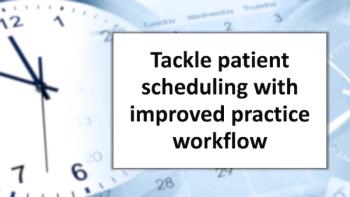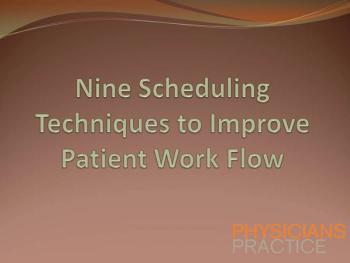
Scheduling problems are a practice-wide issue, affecting every staff member. Here's how to better understand what's not working and fix it.

Scheduling problems are a practice-wide issue, affecting every staff member. Here's how to better understand what's not working and fix it.

Good clinical outcomes require strong patient participation. One way to engage your patients is to improve their experience at your practice.

Your practice is a reflection of the physicians who work there. If it looks old and uncared for, patients might wonder about the care they will receive.

Adding a new physician to your practice requires a sound communication plan that encompasses your patients, social media, and staff.

A practice depends on an excellent staff, which doesn't come together by accident. Here are six keys to building a quality group.

As a specialist when you participate in a lunch and learn, remember, it's not so much about the lunch; it's more about relationships.

Good clinical outcomes require strong patient participation. One way to engage your patients is to improve their experience at your practice.

If your staff is faced with a daily workload that leaves them frustrated and worn out, it may be time to think about outsourcing.

Research reveals reporting discrepancies between primary-care and specialty practices. How can you improve the lines of communication?

Hiring the right candidate for your medical practice is not the easiest task. But if you prepare beforehand and ask the right questions, you can.

Consultant Judy Capko provides nine ways to effectively meet your practice's scheduling demands.

Group visits are an opportunity for busy practices to solve patient-demand problems, and to make sure patients get the care they need.

Rather than disparage walk-in clinics, make an effort to reach out and form a collaborative arrangement. Both your practice and patients could benefit.

Let's face it, medicine is a business. If your new physician isn't productive, your practice will suffer. Here are some strategies to speed things up.

Holding staff accountable is crucial to your practice's success. Doing so will make sure that everyone is committed to both the practice and patients.

Even dedicated staff can sometimes have tunnel vision. But unless team members work together to achieve practice-wide goals, productivity suffers.

It is important for practices to participate in patient-centered programs in order to focus their culture on improving the patient experience.

Physicians can often be pulled in too many directions. Developing strategies to better manage time is one solution.

Technology is an important factor in improving the way you care for your patients. Unfortunately too many practices fail to use it to communicate with them.

Without everyone's cooperation in your practice, change results can be compromised. Here are a few steps you can take to avoid sabotage.

Do you know what type of role you want your practice manager to take on? Be clear about your expectations upfront.

Most medical practices experience some type of patient bottleneck. The good news is there's a solution, if you just look hard enough.

Patient access is getting increased attention through reform initiatives. Here are five steps you can take to make sure patients get appropriate access to care in your office.

Many physicians appear invisible when someone does an Internet search - unless they want to be lost in the fray, it is up to them to make sure they have an accurate listing.

Marketing is a powerful tool that physicians can use to build up their practices and foster improved professional relationships.

There are many misconceptions about what it takes to be effective in marketing a medical practice. The best approach is to have a plan - a comprehensive, written marketing plan.

You may be a good leader at your medical practice, but becoming great requires good instincts, experience, and hard work.

A natural solution to an increased workload is to recruit for a new physician. Having a plan makes the process much more effective for both the new recruit and your practice.

Many practices make common collection mistakes that when left unattended can sap revenue. Here's what you can do to improve your collection process.

It's time to say goodbye; here's how to do it without creating collateral damage

Published: July 23rd 2013 | Updated:

Published: January 9th 2014 | Updated:

Published: February 13th 2014 | Updated:

Published: March 12th 2014 | Updated:

Published: September 25th 2013 | Updated:

Published: September 10th 2014 | Updated: